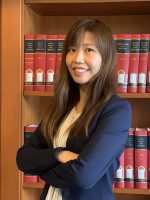
Christine Chan is a JD candidate and the Co-Supervisor of CUHK Medic.Law. She holds a degree in Social Sciences (First Class Honours) from HKU. She has over 10 years of professional experience in public administration. She is also a recipient of the JD Scholarship for Academic Excellence.
Lifting the Veil of Law and Medicine – Public Health and its Legal Education
Abstract:
This conference paper reasserts the necessity for bringing law and medicine beyond the traditional meaning of education. It is paramount to actively engage students and the general public in understanding the dynamics between the two disciplines, with the veil lifted for clearing up the misconceptions.
The paper describes the Medic.Law project (supported by UGC – Project Code: 4170872). The project is spearheaded by two JD candidates and a faculty teaching staff, with the overarching aim of engaging students and practitioners in the legal and medical fields in an interdisciplinary way, and promoting medical law to the general public. Through video-making, designing micro-modules and blog posts, undertaking legal research, and liaising with distinguished speakers at various conferences, the project illustrates how legal education can be transformed from passive learning to active ownership of learning by the students, while promoting the legal literacy of the general public.
Contrary to the conventional notion of legal education being restricted to a classroom setting between teacher-student, legal education can be an interactive process involving everyone, such as having postgraduate students cultivate their pedagogical skills through educating the public on medical law issues.
Diversity can also move beyond the realm of academia to the real world. COVID-19 has raised a myriad of issues and heated debates over mandatory vaccination, social distancing measures and the like, which highlights the importance of promoting medical law to the public. It is imperative for the legal and medical practitioners to embed their knowledge in the practical world to understand the concerns of the public. At the same time, the public should be given the chance to understand their rights and responsibilities through becoming informed on the relevant legal and medical requirements. The Medic.Law project shows one way of achieving these goals.
Law and Medicine are two distinctive yet morally connected disciplines. With the long history of traditions in both areas, diversity could hardly be associated with them. The intricacies of law and medicine are yet to be resolved. Will diversity of the education be the way out?

